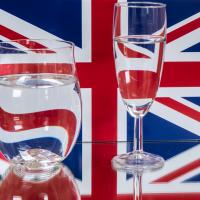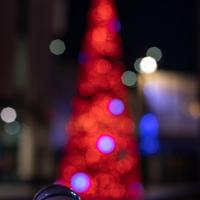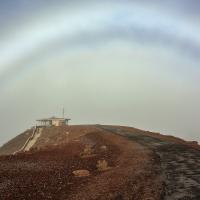Another week of lockdown . Another week when the IOM Photographic Society was forced to cancel its weekly meeting . Another week when a Zoom session provided the photographic interest for our members. Fortuitously, it was on the subject of refraction images, a topic ideally suited to a lockdown as they are images which can be taken in the home with no need to travel or mix with other households, and which will provide hours of interest to children as well as adults.
We have all seen refraction who hasnt played by a stream and put a stick into the water and seen the stick bend? That is refraction in action, and is due to the speed at which light moves in different substances. In water, light moves slower than it does in the air, so it bends and thus objects such as our stick appear to bend as well, and may appear closer and larger than they really are. A rainbow is also refraction in action. Light not only bends when it moves through a medium that slows it down, but the constituent colours within white light move at different speeds too. So the large water droplets of rain break down the white light of sunlight into the spectrum of colours we see in a rainbow red, orange, yellow, green, blue, violet and indigo. - each droplet acting as a lens.
Snells Law describes the physics of this process in detail the angle of the bend varying depending on the refractive index of the medium - but glass, water, telescopes and spectacles are all household objects which demonstrate refraction. Claire Schreuders image of a Christmas tree in Strand Street and taken through a glass globe shows the tree in focus but upside down and the wrong way round another variation on light with the globe serving as a lens. My shot of a white rainbow (also known as a fogbow) was taken in cloud at an altitude of 10,000 feet high up on Haleakala on Maui rainbows appear when sunlight is refracted through rain consisting of fairly large droplets of water, but fog or cloud consists of much smaller water droplets so the light doesnt spend enough time within the droplet to separate the colours of a full spectrum, and leaving just a circular white haze. The more usual refraction shot is a coloured background shot through a glass (or several glasses) filled with water and allowing the bend to be shown as in the image of the union jack shown here. The amount of distortion bend will vary depending on the shape of the container as well as the substance through which the light is travelling but an experiment well worth trying during lockdown, and one children may find interesting as well as educational.
Given the current Covid-19 situation, our programme is in abeyance and we are unable to provide a date for our next meeting, so please check our website www.iomps.com or our Facebook page for details of any updates or changes. Our meetings are held the St John Ambulance HQ on Glencrutchery Road, starting at 7:00 pm and are open to the public (non-members with a modest entry fee), and all will be given a very warm welcome.
The Isle of Man Photographic Society is supported by the Arts Council
Chris Blyth
CAPTIONS:
IMAGE 01: Flag Refraction by Chris Blyth
IMAGE 02: Refraction Globe by Claire Schreuder
IMAGE 03: Haleakala Fogbow by Chris Blyth



